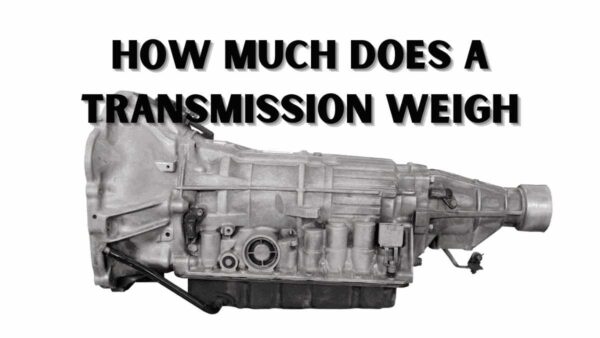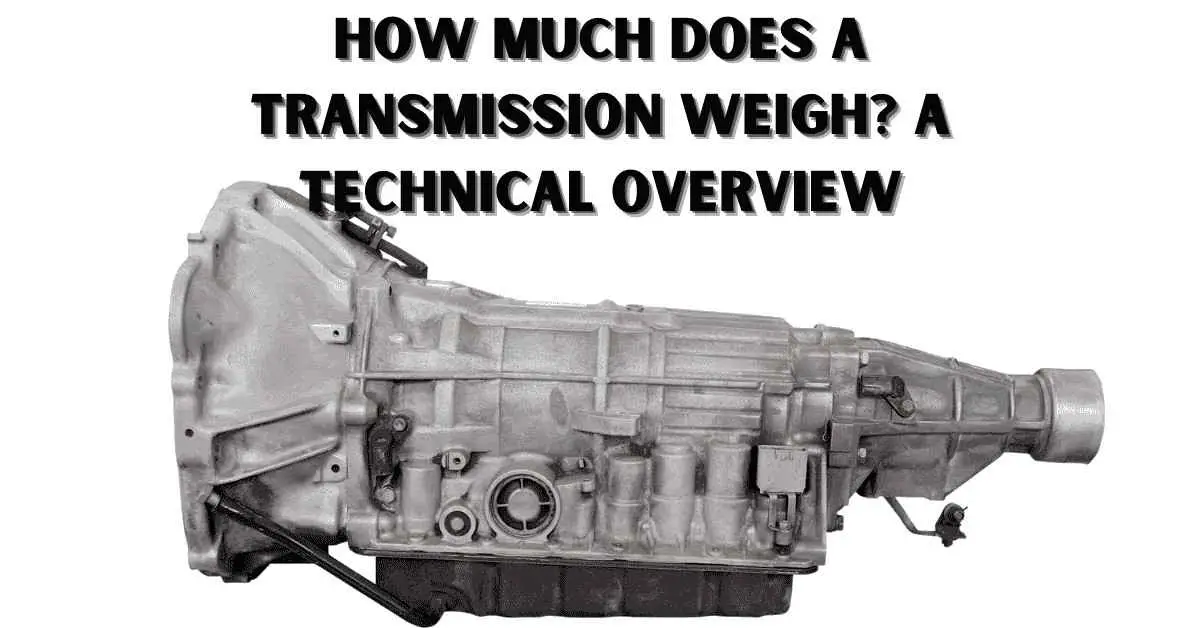Understanding automotive components is essential for every car owner. One common question is, how much does a transmission weigh? In this article, we examine transmission weight, discuss factors that influence it, and explain the differences between various transmission types. We aim to provide clear, researched information in a friendly tone to help you make informed decisions regarding your vehicle.
Introduction

When you ask how much does a transmission weigh, you want to understand the numerical answer and the factors that affect this weight. Transmissions are critical to a car’s performance, and their weight can influence fuel economy, handling, and overall vehicle balance. This guide will explain the weight range of different transmission types, discuss the materials used in construction, and explore why knowing the weight is essential for repairs or custom builds. Our goal is to offer simple, accurate information that is easy to understand.
What Is a Transmission?
A transmission is a mechanical component that transmits engine power to the wheels. It adjusts the engine’s torque and speed to suit different driving conditions. In simple terms, a transmission allows your car to accelerate smoothly and efficiently. There are two main types of transmissions: manual and automatic. Each type has unique design features that affect its weight. Additionally, some modern vehicles use continuously variable transmissions (CVT) or dual-clutch transmissions (DCT), which have different weight characteristics.
Why Does Transmission Weight Matter?
The question of how much a transmission weighs is essential for several reasons. First, the weight of a transmission affects the overall weight distribution of a vehicle, which in turn influences handling and ride quality. Second, knowing the weight is crucial when replacing or rebuilding a transmission, as it can impact installation and balance. Finally, the weight can affect a car’s performance and fuel efficiency, making it a key consideration in automotive design and engineering.
Factors That Influence Transmission Weight
Several factors determine how much does a transmission weigh. The design, materials, and type of transmission all play significant roles. Let’s explore these factors:
Type of Transmission
Different types of transmissions have various designs and components. For example, manual transmissions typically weigh less than automatic transmissions due to their more straightforward construction. Automatic transmissions, on the other hand, contain additional components such as torque converters and complex hydraulic systems, which add to their weight.
Materials Used in Construction
Modern transmissions are built using a combination of metals, alloys, and sometimes composite materials. The choice of materials directly affects the weight. Lightweight materials like aluminium are often used in high-performance vehicles to reduce overall weight, while heavier metals such as steel may be used in standard models for durability.
Size and Capacity
The size of the transmission, including the number of gears and overall capacity, also impacts its weight. Transmissions designed for high-torque engines or heavy vehicles tend to be larger and heavier. Conversely, smaller transmissions in compact cars are lighter.
Design and Efficiency
Advancements in engineering have led to more efficient designs that can reduce weight without compromising performance. For instance, computer-aided design (CAD) allows engineers to optimize the structure and reduce excess material, thereby lowering the overall weight.
Additional Components
Components such as the torque converter, valve body, and fluid cooling systems add to the overall weight of automatic transmissions. Each of these parts is necessary for smooth operation and can influence the transmission’s weight.
Weight Ranges for Different Transmission Types
Understanding the typical weight ranges can help answer how much a transmission weighs. Although the exact weight varies by model and design, we can provide general estimates.
Manual Transmissions
Manual transmissions are generally lighter. They may weigh between 100 and 150 pounds (45 to 68 kg). In high-performance or racing applications, lightweight materials can lower this weight. The simplicity of a manual transmission, with fewer components, is a significant factor in its lower weight than an automatic.
Automatic Transmissions
Automatic transmissions are typically heavier because they incorporate more complex systems. An automatic transmission weighs 150 to 250 pounds (68 to 113 kg). Some larger or heavy-duty automatic transmissions can exceed 300 pounds (136 kg). The additional weight comes from components like the torque converter and more extensive gear systems.
Continuously Variable Transmissions (CVT)
Continuously variable transmissions (CVTs) offer a different design. They are engineered for smooth, seamless acceleration. Depending on the vehicle’s design and application, their weight generally falls in the range of 100 to 200 pounds (45 to 91 kg). Their unique belt-and-pulley system can sometimes be lighter than traditional automatic systems.
Dual-Clutch Transmissions (DCT)
Dual-clutch transmissions (DCTs) combine the efficiency of manual transmissions with the convenience of automatics. They typically weigh 150 to 220 pounds (68 to 100 kg). The design of a DCT often involves compact and efficient components, but the additional clutches and control systems can add to the overall weight.
How Is Transmission Weight Measured?
Measuring the weight of a transmission is straightforward. In manufacturing, the transmission is weighed on industrial scales, and the specifications are provided in the vehicle’s technical manual. Technicians may remove the transmission and measure it independently for aftermarket repairs or custom builds. Accurate weight measurements are essential for ensuring proper vehicle balance and performance.
The Role of Weight in Vehicle Performance
The weight of a transmission plays a significant role in overall vehicle performance. Here are some key points to consider when evaluating how much does a transmission weigh about your car:
- Fuel Efficiency: Lighter transmissions improve fuel economy by reducing the vehicle’s overall weight.
- Handling: A balanced weight distribution is critical for good handling. The transmission’s weight affects the centre of gravity and can influence how a car responds during turns.
- Acceleration and Braking: Excess weight in the transmission can reduce acceleration efficiency and affect braking performance.
- Durability: While lighter transmissions can enhance performance, they must also be durable enough to handle engine torque and daily wear. Manufacturers strive to balance weight reduction with structural integrity.
Advances in Transmission Technology
Recent technological advancements have led to lighter, more efficient transmissions. Engineers now use advanced materials like carbon composites and aluminium alloys to reduce weight without sacrificing strength. In addition, innovative design techniques, including 3D modelling and simulation, enable manufacturers to optimize the structure of transmissions. These improvements are helping to lower the overall weight and improve fuel efficiency, answering the question of how much a transmission weighs more precisely for modern vehicles.
Considerations for Replacement and Upgrades
Knowing how much a transmission weighs when considering a replacement or upgrade is essential. Weight is a key factor when installing aftermarket transmissions or custom-built systems. Here are some considerations:
- Compatibility: Ensure the replacement transmission matches the vehicle’s weight and dimensions.
- Performance Impact: Consider how the weight of the new transmission will affect your vehicle’s performance, handling, and fuel economy.
- Installation: A significant difference in weight from the original component may require modifications to the mounting and balance of the vehicle.
- Cost vs. Benefit: Lighter transmissions often come at a premium price, so weigh the benefits against the cost of the upgrade.
Expert Insights on Transmission Weight
Industry experts emphasize that understanding transmission weight is not just a matter of numbers but also of context. For example, performance enthusiasts may prioritize weight reduction for better acceleration and handling, while everyday drivers might value durability and reliability over a slight weight advantage. By considering the technical specifications and the vehicle’s intended use, consumers can better answer how much a transmission weighs and how it fits into their overall vehicle performance goals.
Practical Tips for Car Owners
If you are a car owner wondering how much does a transmission weigh and how it affects your vehicle, consider these practical tips:
- Consult Your Vehicle Manual: The technical manual for your car typically provides detailed specifications, including transmission weight.
- Ask a Professional: If you are considering a replacement or upgrade, consult a certified mechanic or automotive engineer.
- Research Specific Models: Transmission weight can vary significantly between models and manufacturers. Look up reviews and technical documents for the most accurate information.
- Consider Overall Vehicle Weight: Remember that the transmission is just one component. Evaluate its weight in the context of your entire vehicle for a more complete picture of performance and balance.
Frequently Asked Questions
Q1: How much does a transmission weigh on average?
A: A manual transmission weighs between 100 to 150 pounds, while an automatic transmission weighs between 150 to 250 pounds. CVTs and dual-clutch transmissions fall within similar ranges.
Q2: Does a lighter transmission improve vehicle performance?
A: Yes, a lighter transmission can improve fuel efficiency, handling, and acceleration. However, it must also be durable enough to handle daily wear and engine torque.
Q3: What factors influence transmission weight?
A: Factors include the type of transmission, the materials used in construction and design, and additional components such as torque converters in automatic transmissions.
Q4: How can I determine how much my vehicle’s transmission weighs?
A: Check your vehicle’s technical manual or consult with a professional mechanic who can provide precise measurements.
Q5: Are there benefits to upgrading to a lighter transmission?
A: Upgrading to a lighter transmission can enhance performance, but compatibility, durability, and overall vehicle balance must also be considered.
Future Trends in Transmission Design
The future of transmission design promises further weight reductions and efficiency improvements. With the rise of electric and hybrid vehicles, engineers are rethinking transmission designs to suit new powertrain configurations better. These innovations will likely answer how much a transmission weighs in more specific terms for different types of vehicles. Advances in materials science and engineering design will play a critical role in these future developments.
Conclusion
In conclusion, determining how much does a transmission weigh depends on various factors, including the vehicle’s type, materials, design, and intended use. While manual transmissions generally weigh less than automatics, modern design innovations are bridging the gap between performance and efficiency. Understanding the weight of your transmission is crucial for maintaining vehicle performance, ensuring proper balance, and making informed decisions about replacements or upgrades. By considering all these aspects, car owners can appreciate the complex engineering behind one of the most critical components of their vehicle.

